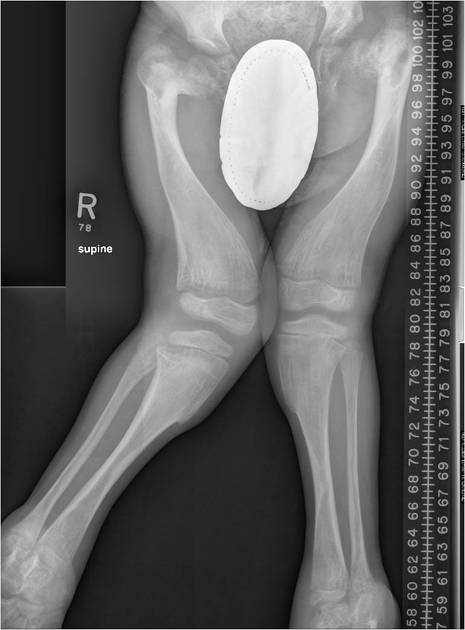Presentation
The patient is known to have Stuve-Wiedemann Syndrome with lower limb deformity. X-rays performed to assess possible surgical correction. The patient developed multiple episodes of seizure during early infancy which was resolved later on. He had multiple corneal ulcers as well.
Patient Data

X-ray of bilateral lower limbs shows short limbs with bowing deformity, bilateral coxa vara and valgus deformity more on the right.
Widening of femoral and tibial metaphysis with blurred margins, abnormal trabecular pattern and destruction of femoral heads also noted.

The patient developed a fracture of proximal right femoral diaphysis after minor fall which was treated with intramedullary nail fixation.

Post osteotomy of the right tibia and femur with Tylor frame.

Improvement of bowing deformity after surgical correction. Note the lateral dislocation of the right patella.
Case Discussion
Stuve-Wiedemann syndrome (previously known as Schwartz Jampel syndrome type 2) is a rare autosomal recessive skeletal disorder. Due to consanguineous marriages, it is seen more commonly in the United Arab Emirates.
Some characteristic features of this syndrome include bowing of the long bones (campomelia) with lower limbs affected more than the upper limbs leading to short stature, and permanently flexion contracture of fingers and toes (camptodactyly) with ulnar deviation.
Other features might be seen such as: elbow contractures, talipes valgus, spinal deformities, flared iliac wings, hypoplasia of the lower ilia, micrognathia, hypotonia and osteopenia with increased risk of spontaneous fractures.
Early mortality can be due to developing life-threatening complications including sudden hyperthermia, apnoea, aspiration due to feeding problems, and respiratory distress.
The definite diagnosis requires genetic testing.
Treatment needs a multidisciplinary approach involving multiple specialities such as Paediatrics, Ophthalmology, Orthopaedic surgery and physiotherapy.






 Unable to process the form. Check for errors and try again.
Unable to process the form. Check for errors and try again.